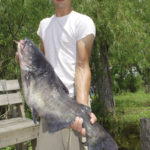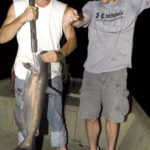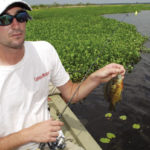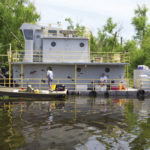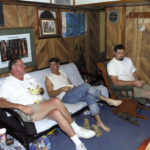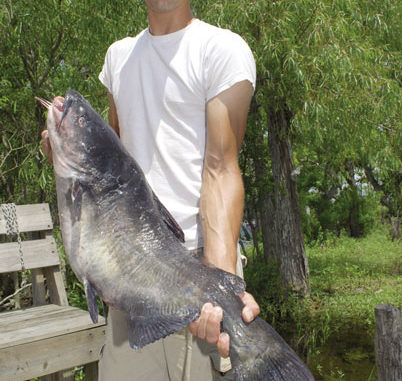
This crew goes toe to toe with wicked catfish in the swamps of Terrebonne Parish.
In the dense night air of the remote northwestern Terrebonne Parish freshwater marsh-swamp, gills might have been more appropriate for breathing than lungs. The searing surge of light from the Q-beam illuminated a big white styrofoam float bobbing and dancing ahead on the surface of the still bayou water.
“This looks promising,” pronounced Chip Crews, the boat’s pilot.
The three young men in the boat tensed up. But the big float began moving away from the noise of the boat.
“Oh-oh, he’s making a run for it,” said Elbe (pronounced ‘L.B.’) Weinberger.
The third man, Chris Forsyth, quickly moved to the bow of the big aluminum flatboat to be in position to snare the float as soon as it got close enough. He leaned out over the water, and when the float got within inches of his fingertips, it disappeared beneath the surface in an eye-blink. Forsyth’s jaw sagged open, and he turned wide-eyed to his companions.
This was a big catfish.
Ten- and 12-pounders make the big corks, normally used to mark crab traps, barely bob. The cork went so deeply underwater that Crews couldn’t locate its gleam in the clear black water with his powerful Q-beam. The men’s heads swiveled in all directions, frantically scanning for the cork. They wanted this fish.
Suddenly, less than 15 feet from the boat, the cork erupted violently from the water’s surface. So deeply had it been submerged that it flew 2 feet into the air.
“I hope that’s not it,” murmured Crews.
But all three men knew it was. Forsyth retrieved the limp jug line, and looked at the dropper. The fish had snapped the 80-pound test line like it was thread. Muttering unprintable oaths, the three dejected men went on to run the rest of their jug lines.
The overnight fishing trip was headquartered out of Crews’ father’s duck hunting camp located at the head of Turtle Bayou. Fifty-year old Louis “Woody” Crews Jr. provided an irresistible invitation for the trip by saying without equivocation, “We got catching big blue cats down pat. We’ve got them figured out.”
Strong words.
The senior Crews, along with his two sons, 25-year old Louis “Chip” Crews and 21-year old Stephen Crews, and three of his sons’ friends, Forsyth, Jordon Montgomery and Weinberger made short work of getting the boats unloaded and the camp set up and ready to fish.
The camp, the Miss T, was impressive — a 50-foot steel, self-contained houseboat resembling a cross between a yacht and a tugboat. Originally built for leisurely cruising on the larger rivers of Alabama, the boat is owned by Michael Samanie, one of Crews’ two duck-lease partners.
During waterfowl season, the partners and their family and friends use the camp intensively for duck hunting. But from the end of duck season through June, Crews uses the camp several times a month for another of his favorite pursuits, catching big blue catfish on jug lines.
Later, beginning some time in June and into July, Crews begins fishing offshore, targeting the rips for tuna, dolphin and marlin. In late July, August and September, the rips are often farther offshore. When they are close enough, he targets pelagic fish; when they aren’t, he is banging on snapper, cobia and grouper.
But now it’s big catfish he’s after, ones big enough to have shoulders on them, gran hombres. May and June are prime months to whack them.
The key, Crews says, to catching the big fish is to use live bait, more specifically live “perch.” The word “perch,” as used by the men, is a catch-all term that includes a number of species of fish in the sunfish family, including, but not limited to, bluegills, redear sunfish, spotted sunfish and an occasional goggle-eye or crappie thrown in.
“Catching perch for bait is half the fun,” said Crews with a big grin.
He immediately bent the five young men to the job of producing the baitfish with cricket-baited rods and reels. The men were coached by the amiable giant’s constant advice, three-quarters of which seemed to be cheerfully ignored.
They planned to bait the 25 or so jug lines shortly before dark, then run them and rebait them again about 10 p.m. Allowing for some of the perch to die before being used, they would need to catch 75 or so baitfish to be sure they had enough. The final run would take place early the next morning, but no bait would be needed for this run because the lines would be picked up and stowed.
Fishing for bait began right off of the houseboat itself, but it played out before enough perch were produced. They caught the rest of their needed baitfish in open ponds in the marsh of their duck lease. Immediately after being caught, each perch was put in a circular aerated live tank.
The men joshed and teased a great deal while fishing. Obviously, some competition was occurring. The biggest problem didn’t seem to be that they couldn’t catch enough fish, but rather that the perch were too big. Fish about 4 inches long were dubbed “ideal.” A lot of the ones they caught were big enough to fillet.
At 4 p.m., with Stephen Crews piloting the boat, they began to set out the baited jug lines in the bayous and canals near the camp. They picked spots that they favored because of good catches made previously, but very often the lines were set near an opening from the waterway into interior marsh ponds. Their objective was to intercept fish moving to and from the shallow marshes to feed.
The scenery was seductive. The vast, sweeping, open flotant marshes were blanketed with Louisiana irises, cattails and a riot of other aquatic plants. Rimming the expanses and dotting them occasionally were cypress and willow trees, along with that ubiquitous invader, the tallow tree. All of it was the vibrant bright green of early summer, so much more appealing than the heat-weary dark greens worn by the same plants in August and September.
By 6 p.m., the lines were baited and soaking, and the men retired to putter around the camp while the elder Crews prepared a wild duck and goose, chicken and turkey, smoked sausage gumbo. The cool darkness inside the camp was a welcome relief from the glare and heat of the outdoors.
Talk drifted to their quarry. The men clearly enjoyed pursuing the big fish. In late April, the elder Crews hauled in a 57-pounder.
“It took us a while to figure out how to catch these big fish,” he said. “For many years, we used jug lines with the hook leaders tied on near the bottom of the line. Mostly what we caught were mud cats and choupiques. A friend told us to put the hook near the cork rather than the weight.”
That helped, but they still weren’t catching big fish until another friend tipped them to the use of live perch.
“Those big catfish can’t resist a live perch,” he said with a grin.
But these weren’t just trophy fish to the Crewses. They also clearly enjoyed the culinary attributes of blue catfish.
The elder Crews shook his head as he talked.
“Most people are used to eating farm catfish,” he said. “They are soft and mushy. These fish are firm and white. They rank with grouper.”
Crews should know. He catches a lot of both kinds of fish.
He went on to explain that they fillet all their catfish. On big fish, they “fillet the fillet,” to produce a thinner, easier-to-cook piece of fish. Crews also explained that to get the best product, the silver under-skin that is found on one side of each fillet should be removed with a sharp knife.
“I love them,” chimed in Stephen Crews. “They are good any way we cook them.”
The younger Crews took the conversation back to catching the beasts.
“There are a lot of things that must be done right to catch these fish,” he said. “If the perch is so big that it fills up the interior of the circle hook with its body, it is too big and the hook won’t work. Also, be sure to remove any perch scales lodged on the tip of the hook. One scale on the tip will interfere with how the hook works.”
With his father nodding sagely in the background, Crews continued.
“Use tarred black nylon twine for mainlines on the jug lines. It works better than anything else. And when you run the jug lines, be sure to lift the jugs very slowly to keep from over-exciting the fish. You want to prevent the hooks from pulling out of their mouths.”
At 10 p.m., Chip Crews, Forsyth and Weinberger left the camp to make the night run. A bright full moon was hanging over the eastern horizon like it was suspended on a string. As the men’s boat idled away from the camp, the gentle murmur of the camp’s generator was replaced by a chorus of croaking frogs. It seemed that everywhere Crews shined the Q-beam the bright red glowing embers of alligator eyes shined back at the men.
Crews piloted and held the Q-beam. Forsyth grabbed the floats and retrieved the jug lines, and Weinberger dipped bait and provided back-up for Forsyth. One unspectacular (to them) 8- to 12-pound fish followed the other into the boat, until the big one got away.
Still numb from the loss of the big fish, the men kept running their lines. Three lines later, a set of bright red eyes was ensconced next to a cork.
“Oh man, we got a big alligator on the next one,” groaned Weinberger.
“Yeah, and we have to get the line back from it so that we don’t lose it,” added Crews.
Every time Crews got the boat near the cork, the alligator would dive and take the cork under and disappear. Back and forth and up and down the bayou the chase went on. Sometimes the big white cork would disappear in the inky clear water, and other times it would fly away from the boat at an incredible speed just beneath the surface. Finally, near the center of the bayou, the alligator stopped, but didn’t surface.
Slowly the boat approached the cork. Forsyth reached out with a gaff hook to grab it. When he did, the devil broke loose. Forsyth struggled mightily to keep his grip on the gaff. Weinberger stood behind him with his hands held in preparation to grab him should the alligator threaten to drag him overboard.
The 10-foot alligator’s huge head reared thrashing from the surface. Its mouth was wide open. Incredibly, it roar-groaned loudly like a dragon. Water flew everywhere, and everything was happening in a blur.
Then it was gone. Thankfully, the leader had broken.
Midnight found the three back at the camp. No one was saying much.
At 6:30 the next morning, dawn crept softly over the lush semi-jungle foliage of the landscape. A blue haze hung over the water, and the still air was semi-tropical in humidity.
Last run. Montgomery had to return to civilization the previous evening for a work emergency, but all five of the other men set out for what they hoped would be the best run of the trip.
And so it was. Almost every line seemed to hold a fish. The two-hour run was a collage of mental images: bouncing white corks that had to be run down by the boat; big slate-gray heads with beady eyes emerging from the water; gaff hooks slamming into thick, wide bodies and heads; men grunting and water flying everywhere.
By 10 a.m., they were done. For the trip, two 110-quart ice chests had been filled to their brims. Several fish weighed over 20 pounds, with the largest being 27 pounds. The company had been good, the food just as good and the scenery spectacular.
Crews settled his 6-foot, 6-inch, 275-pound frame on a wooden seat on the dock for the camp. He sat quietly for a few moments before looking up and asking, “When can you come back and catch a big one?”
